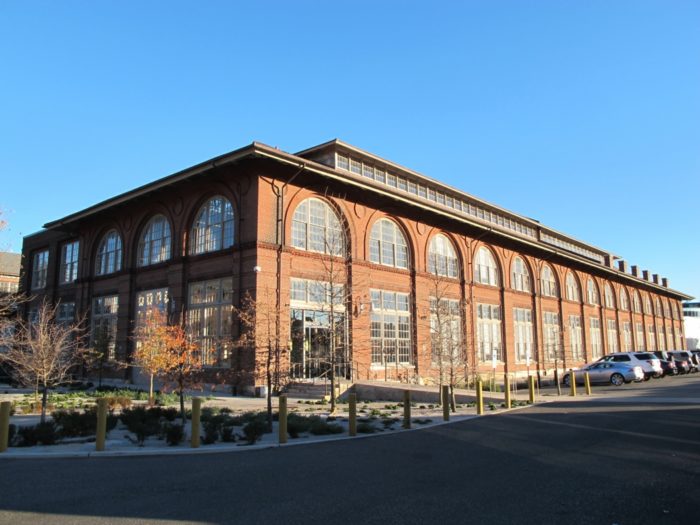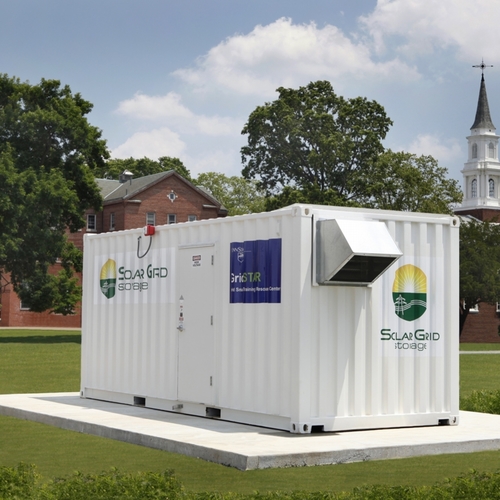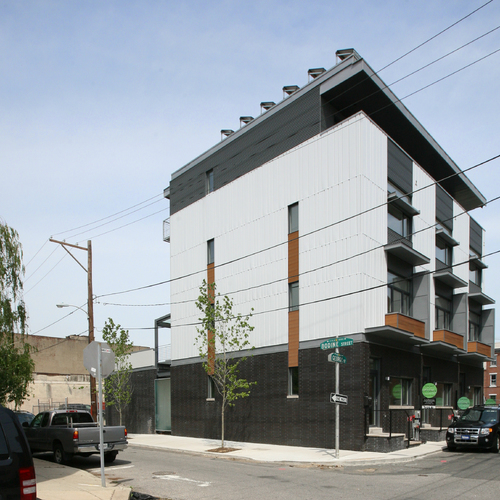
Image Credit: All photos: Alex Wilson
Image Credit: All photos: Alex Wilson The Navy Yard occupies 1,200 acres. The restored buildings now house more than 300 vibrant businesses. The shiny metal units in the foreground are part of a 600-kW solid-oxide fuel cell installation at the Navy Yard. This electrical generation system uses natural gas. This Bloom Energy fuel-cell system provides 60% of Urban Outfitters' power needs. The GridSTAR net-zero-energy demonstration house at the Navy Yard includes a car-charging station for electric vehicles. The roofs of the GridSTAR house include several types of solar collectors. A unique solar shingle product is installed on the roof of GridSTAR house. It's hard for specialized solar panels like these to compete with standard panels. The utility room includes a Stiebel Eltron solar hot water tank. The taller tank to the right is the Stiebel Eltron heat-pump water heater. This metal cabinet in the GridSTAR home contains a lithium-ion battery bank that provides back-up power.
I’m just back from Philadelphia, where I spent most of last week at GreenBuild, the nation’s premier conference and expo focused on the burgeoning green building movement. I heard there were 25,000 attendees.
Several of us from BuildingGreen drove down the day before the conference started, and Brent, Candace, and I didn’t have any commitments on Tuesday afternoon, affording us the opportunity to visit The Navy Yard, which I had been hearing a lot about.
New life for an old military base
The Philadelphia Naval Shipyard, which had its origin in 1776 and relocated to the present site at the confluence of the Schuylkill and Delaware Rivers in 1871, was the nation’s first naval facility. Fifty-three naval ships were built here, including the famed New Jersey and Wisconsin battleships in World War II; some 574 ships were repaired here. At its peak in the 1940s the shipyard employed 40,000 people.
The shipyard was largely shut down in 1995, though some Naval operations have been retained on the site. The Navy Yard, as it is now known, was considered an eyesore to many, with derelict buildings and infrastructure sorely needing a facelift, but some saw the potential of this property. The City of Philadelphia took over the facility and, with various partners, began working to make it into a driver of economic development through the Philadelphia Industrial Development Corporation.
Today, the Navy Yard, which occupies 1,200 acres, houses more than 300 vibrant businesses that employ 10,000 workers. The facility got a major boost and critical mass in 2006 when Urban Outfitters moved its corporate headquarters into four large renovated buildings there; the company (which owns the Anthropologie and Free People brands) currently employs 1,400 workers in 400,000 square feet of commercial space.
This year, the pharmaceutical company GlaxoSmithKline relocated from Suburban Philadelphia to a newly built 208,000 square-foot corporate headquarters building that has achieved LEED Platinum certification. Liberty Property Trust, one of the nation’s leading green-focused real estate investment trusts with 67 LEED projects either completed or underway, has been the guiding force for much of the real estate development at the Navy Yard.
Master planning at its best
Many of the most progressive development projects today are occurring on sites where large-scale master planning is possible. That has often been the case where military bases are shut down. The Navy Yard may be the most successful such project yet.
Robert A.M. Stern Architects led the master planning process in 2004, and that plan has just been revised with the 2013 Update. Sustainability is a big part of the Master Plan, and that has been driven in part by Philadelphia Mayor Michael Nutter’s goal to make Philadelphia the nation’s greenest large city. It’s an impressive plan that is well-presented in an online document.
An emphasis on green building and public transit links
Among the features in the master plan are the following:
- Mixed-use inner-city development (with 6.2 million square feet of office and research space, 5.7 million square feet of industrial space, and 1,018 housing units planned in the Historic District)
- Continued job creation with 36,000 jobs projected for the Navy Yard at buildout
- Continued emphasis on green building — nine of eleven new buildings at the Navy Yard are LEED-certified
- An extensive network of pedestrian walkways, bicycle lanes, and bicycle paths throughout The Navy Yard
- Public transit links to the nearby Philadelphia International Airport and downtown, including expanded bus routes and feasibility studies underway for a subway extension to the Navy Yard, with two stations
- An extensive collection of stormwater features to manage water onsite and minimize pollution entry into the Delaware River
- Extensive open space, community gathering areas, and buffer zones, with public linkages between neighborhoods (though turf area has to be coordinated with the Federal Aviation Agency to discourage geese — which pose a threat to aviation at Philadelphia Airport).
A smart grid and other energy innovations
Because the Navy Yard is being redeveloped through a central master plan, there are some exciting opportunities that have been realized, including the creation of a microgrid. Microgrids, which are small utility grids that can be separated from the regional power grid when necessary to prevent blackouts, offer important resilience benefits.
There are some exciting power-generation systems being used. After wandering through the cavernous Urban Outfitters corporate headquarters, the three of us from BuildingGreen spent a while trying to find the innovative fuel cell system that powers 60% of the Urban Outfitters’ operations and has reduced their carbon emissions by 52%.
This Bloom Energy solid-oxide fuel cell system uses natural gas to produce electricity, but rather than burning the electricity, as most power plants do, fuel cells operate chemically to produce electricity and waste heat that can be captured. Fuel cells are like batteries that keep operating as long as hydrogen fuel (from natural gas) is provided.
The Navy Yard is housing several other leading-edge energy research programs. The Energy Efficient Buildings Hub (EEB Hub), created by the U.S. Department of Energy and managed by Penn State University, is based at the Navy Yard and has a dual mission of advancing energy conservation in the commercial building sector while spurring economic growth.
The EEB Hub has just completed the GridSTAR zero-net-energy demonstration home at the Navy Yard that we toured. They are also creating the Smart Energy Campus and the Center for Distributed Energy, both of which are based there (though I’m confused about all the brands housed in the EE Hub). Innovative research is being conducted on the use of plug-in electric and electric-hybrid vehicles as a way to provide distributed energy storage for the power grid, utility-scale battery storage to enhance grid reliability, and various renewable energy systems, including a new solar shingle I hadn’t seen.
Master planning makes sense
The Navy Yard demonstrates the benefits of coordinated master planning. While such comprehensive opportunities don’t exist everywhere, elements of such planning, including smart-grid technology and microgrids, can be incorporated widely.
It was exciting to see everything going on the Navy Yard, and I look forward to going back and having more time to explore.
Alex is founder of BuildingGreen, Inc. and executive editor of Environmental Building News. In 2012 he founded the Resilient Design Institute. To keep up with Alex’s latest articles and musings, you can sign up for his Twitter feed.
Weekly Newsletter
Get building science and energy efficiency advice, plus special offers, in your inbox.













0 Comments
Log in or create an account to post a comment.
Sign up Log in